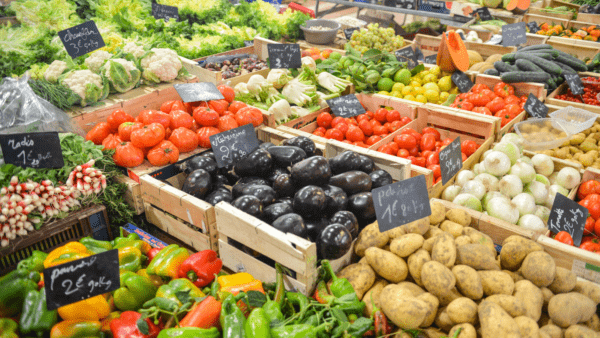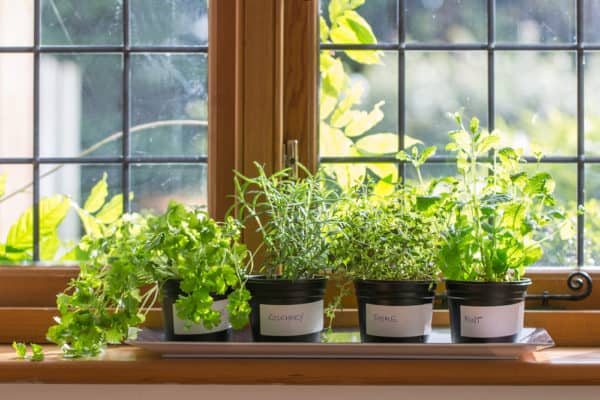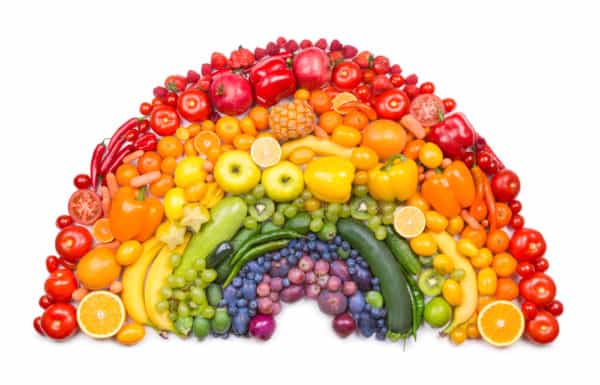Eating more seasonal vegetables and fruits helps to support food producers and reduce food waste. You can find lots of useful information from Veg Power here (opens in new tab).
Let’s take a look at more of the benefits of eating seasonal vegetables and fruit.
Seasonal vegetables and fruit are typically of a higher quality and flavour
Foods that are grown closer to us, don’t usually require long periods of time in transit. This means that we’re more likely to get fruits and vegetables at their peak taste and when they provide maximum nutritional benefit. Vitamin levels can degrade over time, so fruit and vegetables transported overseas for example, may spend a number of days in shipping containers. These foods are likely to have less nutritional value than those requiring minimal transport.
Seasonal foods also contain the nutrients, minerals and trace elements that our bodies need at particular times of the year. Rather than eating the same fruits and vegetables year round, eating seasonally will ensure more variety in your diet and a wider range of nutrients!
Seasonal vegetables and fruit are cheaper and save you money
Eating seasonal vegetables and fruit is cheaper and will help you to cut the cost of your weekly spend on food.When we buy foods in season, we buy it at the peak of its supply, meaning it costs less to farm, harvest and get to the supermarket. It might seem like common sense, but it’s something we often ignore when we’re shopping. It’s easy to fall into the rut of buying the same fruit and vegetables every week without looking at the fluctuating cost. Supermarkets contain much the same fruit and vegetables year round, whether you visit in July or December, however the cost can drastically differ. The first step to take is to “seasonalise” your shopping list.
You can find lots of top tips to Feed Your Family On A Budget in our blog here (opens in new tab).

It’s better for the environment and supports the local economy
Eating seasonally helps to reduce your carbon footprint and supports a more sustainable food environment, but we don’t always give a lot of thought as to how far our food has travelled to get to our kitchen. If the food we buy has come a long way, then it could very well have a heavy carbon footprint. That’s especially likely if our food has travelled by air, due to the high climate impact of planes. In fact, the UK’s Department of the Environment, Food and Rural Affairs (DEFRA) estimates that transporting food within, to and around the UK produces 19 million tonnes of CO2 annually. This is the equivalent of around 5.5 million cars!
While there’s no formula definition of the term ‘local food’, many people feel it’s food that is grown within 100 miles of its point of sale or consumption. The Veg Power campaign highlights that buying vegetables coming into season, helps to support the frontline #FoodHeroes working hard to bring their crops to our tables and reduce the risk of food waste. So by choosing food produced locally, you support your local community, and help to keep local producers in business!
To help you buy local foods, try to do a bit of research to find your nearest farmers market and/or farm shops. Try looking on Farming UK (opens in new tab) and The National Trust Website (opens in new tab)

What foods are in season?
June
Asparagus, Aubergine, Beetroot, Blackcurrants, Broad Beans, Broccoli, Cauliflower, Cherries, Chicory, Chillies, Courgettes, Cucumber, Elderflowers, Gooseberries, Lettuce, Marrow, New Potatoes, Peas, Peppers, Radishes, Raspberries, Redcurrants, Rhubarb, Rocket, Runner Beans, Samphire, Sorrel, Spring Greens, Spring Onions, Strawberries, Summer Squash, Sweetheart Cabbage, Swiss Chard, Tayberries, Turnips, Watercress.
July
Aubergine, Beetroot, Blackberries, Blackcurrants, Blueberries, Broad Beans, Broccoli, Carrots, Cauliflower, Cherries, Chicory, Chillies, Courgettes, Cucumber, Gooseberries, Greengages, Fennel, French Beans, Garlic, Kohlrabi, Loganberries, New Potatoes, Onions, Peas, Potatoes, Radishes, Raspberries, Redcurrants, Rhubarb, Rocket, Runner Beans, Samphire, Sorrel, Spring Greens, Spring Onions, Strawberries, Summer Squash, Sweetheart Cabbage, Swish Chard, Tomatoes, Turnips, Watercress.
August
Aubergine, Beetroot, Blackberries, Blackcurrants, Broad Beans, Broccoli, Carrots, Cauliflower, Cherries, Chicory, Chillies, Courgettes, Cucumber, Damsons, Fennel, French Beans, Garlic, Greengages, Kohlrabi, Leeks, Lettuce, Loganberries, Mangetout, Marrow, Mushrooms, Parsnips, Peas, Peppers, Potatoes, Plums, Pumpkin, Radishes, Raspberries, Redcurrants, Rhubarb, Rocket, Runner Beans, Samphire, Sorrel, Spring Greens, Spring Onions, Strawberries, Summer Squash, Sweetcorn, Sweetheart Cabbage, Swiss Chard, Tomatoes, Watercress, White Cabbage.
September
Aubergine, Beetroot, Blackberries, Broccoli, Brussels Sprouts, Butternut Squash, Carrots, Cauliflower, Celery, Courgettes, Chicory, Chillies, Cucumber, Damsons, Garlic, Kale, Kohlrabi, Leeks, Lettuce, Mangetout, Marrow, Onions, Parsnips, Pears, Peas, Peppers, Plums, Potatoes, Pumpkin, Radishes, Raspberries, Red Cabbage, Rhubarb, Rocket, Runner Beans, Samphire, Sorrel, Spinach, Spring Greens, Spring Onions, Strawberries, Summer Squash, Sweetcorn, Sweetheart Cabbage, Swiss Chard, Tomatoes, Turnips, Watercress, Wild Mushrooms, White Cabbage.
October
Aubergine, Apples, Beetroot, Blackberries, Broccoli, Brussels Sprouts, Butternut Squash, Carrots, Cauliflower, Celeriac, Celery, Chestnuts, Chicory, Chillies, Courgette, Cucumber, Elderberries, Kale, Leeks, Lettuce, Marrow, Onions, Parsnips, Pears, Peas, Potatoes, Pumpkin, Quince, Radishes, Red Cabbage, Rocket, Runner Beans, Salsify, Savoy Cabbage, Spinach, Spring Greens, Spring Onions, Summer Squash, Swede, Sweetcorn, Sweetheart Cabbage, Swiss Chard, Tomatoes, Turnips, Watercress, Wild Mushrooms, Winter Squash, White Cabbage.
November
Apples, Beetroot, Brussels Sprouts, Butternut Squash, Carrots, Cauliflower, Celeriac, Celery, Chestnuts, Chicory, Cranberries, Elderberries, Jerusalem Artichokes, Kale, Leeks, Onions, Parsnips, Pears, Potatoes, Pumpkin, Quince, Red Cabbage, Salsify, Savoy Cabbage, Swede, Swiss Chard, Turnips, Watercress, Wild Mushrooms, Winter Squash, White Cabbage.
December
Apples, Beetroot, Brussels Sprouts, Carrots, Celeriac, Celery, Chestnuts, Chicory, Cranberries, Jerusalem Artichokes, Kale, Leeks, Mushrooms, Onions, Parsnips, Pears, Potatoes, Pumpkin, Quince, Red Cabbage, Salsify, Savoy Cabbage, Swede, Swiss Chard, Turnips, Watercress, Winter Squash, White Cabbage.
Seasonal food calendar
Take a look at the following seasonal food calendars to find which foods are in season at different times of the year:
- Vegetarian Society (opens in new tab)
- BBC Good Food (opens in new tab)
- Eat Seasonably (opens in new tab)
Using seasonal food in recipes:
For recipe ideas and inspiration, check out the following sites:
- Early Start Nutrition (opens in new tab) – YouTube Channel
- Early Start Nutrition (opens in new tab) – Recipe Blogs
- First Steps Nutrition (opens in new tab) – Eating well recipe book with simple, cost-effective ideas for the whole family
Can I grown my own?
Absolutely! Whether you’ve got a windowsill, balcony or garden, there are a number of fruits and vegetables that can be grown indoors or in small outdoor spaces. You can pick up some of these seeds in your local supermarket (or even find in your dried herb cupboard!). For example:
- Basil
- Chives
- Mint
- Thyme
- Oregano
- Rosemary
- Cress
- Scallions
- Pea shoots
- Microgreens
- Celery
- Tomatoes
- Carrots
- Lettuce
- Spinach
(note: some of the above plants will need bigger pots and extra space)


